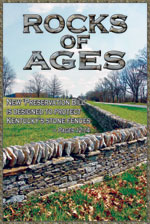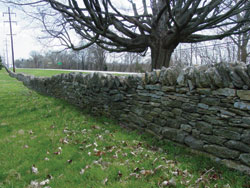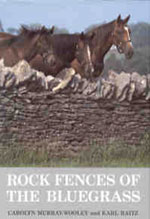



Rocks of Ages
Kentucky
passes bill
to protect state’s stone fences
UK
professor among those writing,
lecturing about preserving them
By
Helen E. McKinney
Contributing Writer
(April 2007) – When Karl Raitz co-authored “Rock
Fences Across the Bluegrass,” he had no idea what type of reception
the book would generate. Fifteen years later, visitors to Kentucky and
residents alike are fascinated with these emblems of a by-gone era.
So much so that Kentucky’s General Assembly recently passed the
“Kentucky Rock Fence Preservation Bill,” known as House Bill
108. The bill provides for the reconstruction and repair of the Commonwealth’s
historic rock fences and mortared rock fences.
 |
|
2007
April Kentucky |
Raitz, Professor and Chair of the Geography Department
at the University of Kentucky, said the idea for a book on this topic
began with a request from the state preservation office. A methodology
had been created for nominating homes, barns and historic districts
for inclusion in the National Register for Historic Places, but no mention
was given to rock fences.
He was awarded a small grant to develop such a methodology. Along with
his research assistants, he gathered enough information for a book,
which he penned with Carolyn Murray-Wooley. The book has been extremely
popular, and Raitz still receives many requests to lecture on the topic.
Rock fences used to dominate the Kentucky landscape but have been disappearing
over the last few decades as progress takes over, reaching a critical
point in 1995. Road improvements, widening, neglect and development
are all factors that have contributed to the decline in rock fences,
said Jane Wooley, Restoration Manager for the Dry Stone Conservancy.
Based in Lexington, Ky., the conservancy strives to revive and promote
the ancient craft of dry stone masonry, in addition to preserving existing
dry stone structures. The conservancy is responsible for initiating
House Bill 108. It will partner with the Kentucky Heritage Council,
the entity that will administer grant funding.
The bill was designed to encourage fence owners to restore their fences
and get a tax credit in the future, said Wooley. Although funding may
not be available until 2008, plans are slowly being put into place to
simplify the application process.
“Every bit of history we are able to preserve is important for
the future,” said Wooley. These fences are an “important and
visible reminder of our history and stewardship of the land.”
Each wall has its own unique agricultural and cultural heritage. There
are many myths surrounding the construction of these fences such as
that most were built by slaves, said Raitz.
Most of the stone masonry can actually be attributed to Irish, Scottish
and English immigrants, he said. It is highly possible that these groups
of people trained a number of African American masons, since there was
an increase in the number of African American masons after the Civil
War, said Raitz.
He has long been fascinated with the technology behind these fences
after moving to Kentucky from Minnesota 37 years ago.
|
Stone
Fence Resources
Dry Stone Conservancy Publications:
• “Rock
Fences of the Bluegrass,” by Carolyn Murray-Wooley and Karl
Raitz; University Press of Kentucky, 1992. |
“Not everybody can build them,” he said. “It
took skill and a certain amount of talent to look at 100 rocks and decide
which ones fit best where.”
A good portion of the fences in question are dry laid (non mortared).
There are many benefits to these dry stone structures: masons need a
minimum of tools, the structures are easily repaired if damaged, they
resist fire, water and insects, and the construction does not deplete
natural resources.
Gravity and frictional resistance hold the stone in place, said Wooley,
since they are stacked one by one. Fences are reconstructed with the
base of the fence wider than the top portion, resembling a pyramid design.
Each new rock is put in place to fit snugly with the previously laid
rock. Pebble-sized rocks may be placed in between larger ones for stability.
Most people think these rock structures are “what makes Kentucky,
Kentucky,” said Rachel Kennedy, Site Identification Program Manager
for the Kentucky Heritage Council. “We want to help people preserve
these historic rock fences and provide an alternative to demolishing
or selling the rocks.”
The rock fences are “a part of the iconic Kentucky rural landscape,”
said Kennedy. What many may not know is that these structures pop up
in more urbanized areas as well.
Many people may not be aware that there are various examples of mortared
structures in central and eastern Kentucky that were built by Italian
immigrants between 1900 and 1940 or 1950, Kennedy said.
In the eastern Kentucky town of Whitesburg, there was an influx of Italians
in the early 20th century at the beginning of the coal and timber extraction
business, said Kennedy. There were also Russian immigrants in this area,
who aided in building rock railroad culverts, retaining walls, churches
and schools.
“These are amazing structures,” said Kennedy. While they may
be newer than most of the rock fences across the state, they are still
worth preserving.
Many of the descendants of these early Italian and Russian immigrants
do not recognize that their ancestors were instrumental in building
these rock structures. Because they don’t realize this significance,
“their history is lost to a certain extent,” said Kennedy.
The Kentucky Heritage Council is responsible for preparing and maintaining
a survey of these sites. The council will identify sites and assist
with any major problems that may arise in reconstruction. This survey
will provide a good idea of what’s out there, said Kennedy.
 |
|
Photo by Darrel Taylor The
stone fence that surrounds the |
One rock fence structure that has been preserved is the
2,000 linear feet of fence stretching in front of the Jefferson Community
and Technical College on Hwy. 60 in Shelbyville. The conservancy held
a series of workshops there beginning in 2003.
James Hedges is the maintenance supervisor at the college and participated
in one of the workshops that trained 211 people. He guessed the fence
to be around 150 years old, but it is hard to date because it has been
rebuilt more than once.
Hedges said the workshops consisted of class instruction, and then participants
tried their hand at reconstructing the actual fence.
“It was a really productive class,” said Hedges. “I would
like to see more of them. These fences are important to history and
the state of Kentucky.”
Hedges praised the craftsmanship of the structure, saying that similar
structures are everywhere across the county. Many lie on private property
“and need to be located and reconstructed because they have eroded
over the years.”
While it was expensive to repair, the end result was worth it to many.
The fence also stretches in front of the Shelby County High School property,
and was less than one foot in some spots, said Joanna Morris, who works
in the office of Grants and Contracts for JCTC.
Federal Transportation Enhancement Funds in the amount of $40,000 were
used, along with Shelby County Fiscal Court and Shelby County Board
of Education each chipping in $5,000. When the college took possession
of the land, many people in the community were concerned over the fate
of the fence, said Morris, who also took part in the workshop.
“The best way to approach this project was as a partnership with
the Dry Stone Conservancy,” Morris said. Since the college’s
goal is to train people, such a project was a natural fit. She said
she hopes the college and the Conservancy will be able to partner again
in the future.
One of the main ways the conservancy promotes fence restoration is by
providing necessary skills and workshops in the spring and fall. They
also offer a dry stone mason certification program. If participants
pass, they are placed on a referral list given out by the conservancy.
“Most fence owners care deeply about their fences,” said Wooley.
“They are important icons of the bluegrass.”
• For more information, contact the Dry Stone Conservancy at (859) 266-4807 or the Kentucky Heritage Council at (502) 564-7005.
